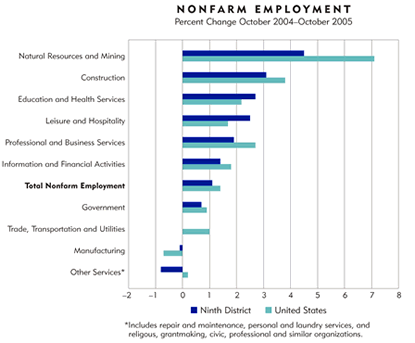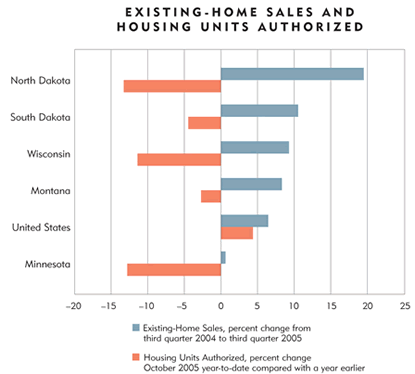The Minneapolis Fed's forecasting models and business outlook poll results describe a district economy that will continue to stretch its legs in 2006 despite higher energy and materials prices, and a likely slowing in home building and residential real estate.
Employment grew in 2005, and the Minneapolis Fed's forecasting models point to continued growth in 2006. However, energy and materials prices rose significantly last year, raising concerns about their effect on consumer spending. In addition, housing units authorized decreased in all district states, showing softness in an industry that has helped support economic growth, particularly during the past few years.
Despite these concerns, employment and personal income are expected to expand. While home building and residential real estate will likely cool in 2006, they are not expected to plummet. Meanwhile, higher energy and input prices will likely dampen agricultural profits in 2006, but farmers should expect solid commodities prices, and early indications are for favorable growing conditions.
Employment shows moderate growth
The outlook for labor markets in 2006 is positive, reflecting expectations for increased economic growth in the district. For next year, the forecasting models and business outlook poll results point to increased employment, relatively low unemployment rates and moderate wage growth.

Source: Bureau of Labor Statistics
A look back at 2005 shows that district nonfarm employment grew 1.1 percent from October 2004 to October 2005, slightly slower than the nation's 1.4 percent growth. Strongest growth was posted by natural resources and mining (+4.5 percent), construction (+3.1 percent), education and health services (+2.7 percent) and leisure and hospitality (+2.5 percent). Meanwhile, manufacturing decreased slightly (–0.1 percent), and other services dropped less than 1 percent (–0.8 percent).
The forecasting models predict continued employment growth in 2006, but at slightly slower rates than in 2005 (see district forecast). In addition, unemployment rates should remain at low levels relative to historical averages. According to the business outlook poll, 33 percent of respondents plan to increase employment at their place of business in 2006; 14 percent expect decreases. Respondents also noted increased difficulty finding available workers compared with the preceding year's poll.
Despite tightening in the labor market, wage growth during the past year was modest, and business outlook poll respondents expect wage growth to remain modest in 2006. District manufacturing wages grew 2 percent during the three-month period ended in October compared with a year ago. While wages grew modestly, growth in employee benefit costs, including health insurance, continued to climb without modesty. Nationally, the cost of employee benefits increased 5 percent during third quarter 2005 from a year earlier, but was down from a 6.9 percent increase during third quarter 2004.
Energy prices don't stop consumer spending
Increases in energy and materials prices have concerned numerous business leaders about potential decreases in consumer spending and profit margins. Prices for fuel, energy and materials for manufacturing and construction increased during 2005. Hurricanes Katrina and Rita disrupted oil and natural gas production, leading to higher gasoline and natural gas prices. Gasoline prices climbed to over $3 per gallon in several areas in September, over $1 higher than a year earlier. While prices softened by the end of November, gasoline was still 20 cents per gallon higher than year-earlier prices. Meanwhile, winter heating costs in many areas are expected to increase 30 percent or more. In addition, prices for petroleum-based products showed significant increases.
Respondents to the business outlook poll and the poll of manufacturers indicated that they expect input prices to increase in 2006, and a majority of respondents plan to pass those increases on to customers in the form of higher selling prices. Nevertheless, energy-related price increases haven't spilled over to the core rate of inflation, which removes price changes for the relatively volatile food and energy sectors. In October, the core consumer price index was a tame 2.1 percent higher than a year earlier.
Several news reports have expressed concern that by spending more to fill the gas tank and heat the house, consumers will spend less for other products and services. Personal consumption expenditure data from the U.S. Department of Commerce's Bureau of Economic Analysis reveal that the share of seasonally adjusted spending on energy goods and services, including electricity, natural gas, gasoline, fuel oil and other energy goods, increased from 5 percent of total U.S. personal consumption expenditure in third quarter 2004 to 6.1 percent in third quarter 2005 due to higher prices. Therefore, the share of spending on non-energy goods decreased by about 1 percent.
However, during the same period, total personal consumption increased by 3.8 percent due in part to solid gains in personal income and some increases in borrowing. While higher energy costs have likely slowed consumption of other goods, those costs haven't resulted in decreases. Nevertheless, effects of higher energy prices vary from household to household based on income. Low-income households are more likely to substitute spending away from non-energy-related goods and services in order to pay for gasoline and heating costs compared with relatively higher-income households.
According to the Minneapolis Fed's forecasting models, personal income should post healthy growth in 2006, a positive sign for consumer spending next year. Respondents to the business outlook poll are optimistic about prospects for sales of their products and services in 2006, but are less sanguine about overall consumer spending in their communities, as 40 percent expect decreases and 22 percent expect increases.
Signs of cooling for housing markets
District housing units authorized showed double-digit growth during 2002 and 2003, which helped boost overall economic growth as the economy moved further from the recession in 2001. However, housing units authorized, a leading indicator of upcoming home-building activity, softened during the past year in all district states. (See chart.)

Sources: National Association of Realtors and U.S. Census Bureau
While authorizations decreased, existing home sales increased during third quarter 2005 compared with a year earlier in all district states, although the increase in Minnesota was small. October data from the National Association of Realtors show that the pace of existing home sales slipped nationally from August and September levels and that the number of homes on the market increased. At the same time, the U.S. Commerce Department reported that sales of new, single-family homes climbed to a record annual rate in October, but several industry experts have described this figure as a likely peak. A primary reason is an increase in borrowing costs; the interest rate for first-time, fixed-rate mortgages climbed to 6.28 percent by the end of November, up from 5.58 percent in June.
Results from the business outlook poll show that a majority of respondents expect home building to decrease in their communities. In contrast, the forecasting model points toward modest gains in housing units authorized during 2006. Overall indications suggest that home building and residential real estate activity will cool during 2006, but will likely not turn into a deep freeze.
Meanwhile, as residential activity softens, commercial real estate and construction has shown signs of strengthening as vacancy rates continued to step down from relatively high levels. Vacancy rates for office space in the Minneapolis-St. Paul area dropped to 15.8 percent during third quarter 2005 from 18.2 percent a year earlier, according to a report by CB Richard Ellis. At the same time, the percentage of available space in large industrial buildings decreased to 8.9 percent during third quarter 2005 from 9.6 percent a year earlier. Decreases in vacancy rates add pressure on rent, prices and future construction.
Agriculture yields great in 2005; input costs dampen outlook for 2006
While crop growing conditions were favorable in 2005 and expect to continue in 2006, price increases for energy and other inputs will likely eat into profits next year. Good weather, large harvests and strong cattle markets provided Ninth District agricultural producers with solid revenues in 2005. In addition, substantial rains reduced the area of drought. However, higher input costs put a damper on profits. The outlook for 2006 is mixed, as preliminary growing conditions are superb, strong prices are expected to weaken a bit and input prices are increasing.
Solid rainfall and decent weather across most of the district aided farmers in producing record harvests in 2005. Ninth District farmers enjoyed increases in total production of corn, soybeans and wheat in 2005 from 2004. These increases were spread across all states in the district except for slight production decreases of wheat in North Dakota and corn and soybeans in South Dakota. District sugar beet production decreased from 2004. Even though grain storage capacity increased, farmers needed to store large quantities of grain on the ground due to carry-over from the 2004 harvest, the large 2005 harvest and transportation disruptions caused by the hurricanes.
Average prices decreased in 2005 for corn (–15 percent) and soybeans (–22 percent). Wheat prices were stable compared with 2004. Input costs, particularly for energy and fertilizer, increased. In addition, high propane prices forced many farmers to dry grain in standing fields.
Cattle producers saw high prices, and many dairy and hog farmers saw profits. Average 2005 cattle prices rose 2.8 percent from strong 2004 levels, while hog and milk prices averaged $50.01 and $15.15 per hundred pounds, respectively, in 2005. However, the number of cattle on feed at South Dakota feedlots decreased 5 percent in November 2005 compared with November 2004.
| AVERAGE FARM PRICES | ||||
|---|---|---|---|---|
| 2002/ 2003 |
2003/ 2004 |
Estimated 2004/2005 | Projected 2005/2006 | |
| (Current $ per bushel) | ||||
| Corn | 2.32 |
2.42 |
2.06 |
1.60-2.00 |
| Soybean | 5.53 |
7.34 |
5.74 |
5.00-5.70 |
| Wheat | 3.56 |
3.40 |
3.40 |
3.25-3.50 |
| 2003 | 2004 | Estimated 2005 | Projected 2006 |
|
| (Current $ per cwt) | ||||
| All Milk | 12.52 |
16.05 |
15.10-15.20 |
13.35-14.15 |
| Choice Steers | 84.69 |
84.75 |
87.09 |
79.00-85.00 |
| Barrows & Gilts | 39.45 |
52.51 |
50.01 |
44.00-47.00 |
| Source: U.S. Department of Agriculture, estimates as of December 2005 | ||||
The outlook for 2006 is mixed. Although parts of the district are experiencing moderate drought, the district is free from the severe drought that plagued the western portions for over five years. Half the winter wheat crop in Montana is rated good or excellent. The U.S. Department of Agriculture has forecast 2006 prices to drop slightly for most major district agricultural commodities. In addition, "very high input costs—fuel, fertilizer, chemicals—are already causing concern over the 2006 production year," commented a Minnesota lender in the Minneapolis Fed's third-quarter (October) agricultural credit conditions survey.
Related articles: |





